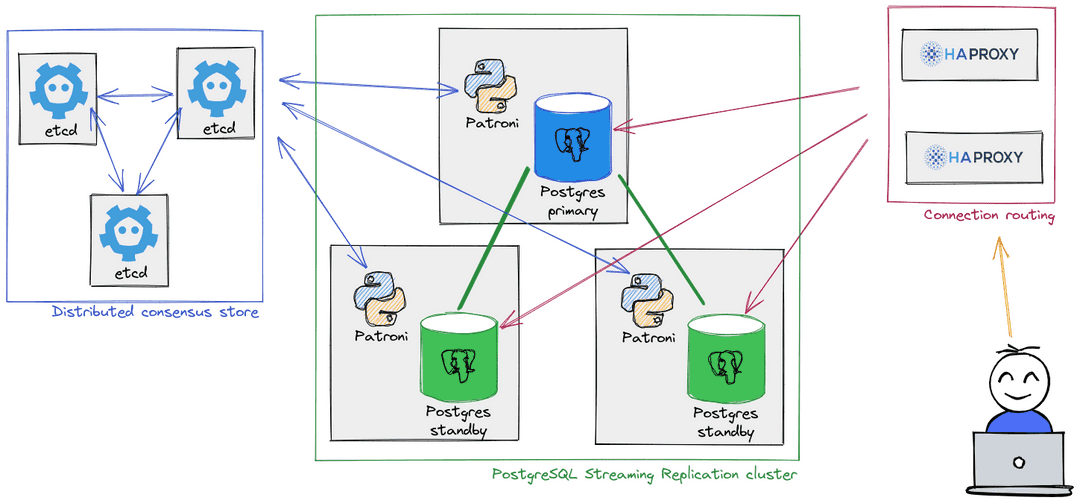Patroni
Suggest editsPatroni is among the most popular open-source tools for managing replication and failover of Postgres clusters. It relies on the Postgres streaming replication and hot standby capabilities. These capabilities allow DBAs to simplify the process of setting up and managing clusters that have high availability and read scalability requirements. EDB has tested Patroni for use with PostgreSQL, EDB Postgres Advanced Server, and EDB Postgres Extended Server.
For the Patroni documentation, see https://patroni.readthedocs.io.
Supported topology
Main high-availability components:
- Postgres cluster — The database cluster, usually consisting of a primary and two or more replicas.
- Patroni — Used as the failover management utility.
- etcd — Used as a distributed configuration store (DCS) containing cluster information, such as configuration, health, and current status.
- HAProxy — Used as a proxy to connect to the read-write and read-only nodes.

Postgres
EDB currently supports using Patroni and Postgres physical streaming replication with a primary server and two replicas, replicating directly from the primary. We support using either PostgreSQL, EDB Postgres Advanced Server, or EDB Postgres Extended Server.
Patroni
Install Patroni on the Postgres nodes. The latest release of Patroni is supported.
Etcd
Etcd is a strongly consistent, distributed key-value store. It provides a reliable way to store data that a distributed system or cluster of machines needs to access.
We strongly suggest using Etcd to avoid data loss in case of split-brain.
For more information, see the etcd documentation.
Note
For production environments, we recommend setting up an etcd cluster of three nodes. One etcd cluster can serve multiple Postgres/Patroni clusters. Install etcd nodes on different hosts from the Postgres nodes.
See Installing and configuring etcd to install and set up etcd.
Watchdog
To avoid split-brain situations, Patroni supports watchdog devices.
Watchdog devices are software or hardware mechanisms that reset the whole system when they don't get a keepalive heartbeat within a specified timeframe. This device adds a layer of failsafe in case usual Patroni split-brain protection mechanisms fail.
Note
While the use of a watchdog mechanism with Patroni is optional, we recommend using it for production environments.
HAProxy
Instead of connecting directly to the database server, you can set up HAProxy so the application connects to the proxy instead. The proxy then forwards the request to Postgres. When you use HAProxy for this purpose, you can route read-only requests to one or more replicas for load balancing.
You can install HAProxy as an independent server, but you can also install it on the application server or the database server.
Note
For production environments, we recommend setting up at least two HAProxy servers. Using various ports, one HAProxy server can serve multiple Postgres/Patroni clusters.
Security considerations
Security considerations are beyond the scope of this documentation. You can find more details about the distributed configuration storage (DCS) and the Patroni REST API in the Patroni documentation.
You can use HTTPS with HAProxy, which is not covered in this documentation.
- On this page
- Supported topology
- Security considerations
Could this page be better? Report a problem or suggest an addition!